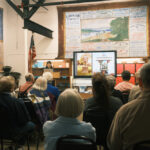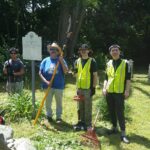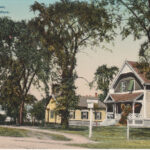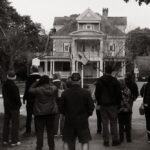
It is impossible to discuss the early history of Attleborough without starting with the general history of Rehoboth. History tells us that 102 pilgrims landed in Plymouth aboard the Mayflower in 1620. By 1630 the flood gates were already open to what is called the “second emigration”and new settlers were pouring into the Boston area.
As the settlers spread out across what is now the greater Boston area, a group from Weymouth under the Rev. Samuel Newman (1600-July 5, 1663) banded together to purchase a tract of land from the native Pokanoket. In 1643 they secured a deal for an area that included some very desirable farmland, as it was free of trees and relatively flat. The land at that time called Wannamoisett and included what is now Seekonk, East Providence, Pawtucket, Rehoboth and a part of Swansea. Rev. Newman and his parishioners populated the land and on June 4th 1645 were accepted as a part of the Plymouth Colony and declared a township with the name Rehoboth.
You may notice that Attleborough, which lies north of these locations, is not on that list. The land north of the new Rehoboth was still not settled and owned by the native peoples, it would remain so for another 17 years.
By 1660 the settlers felt things were getting a bit crowded (10 citizens per square mile) and began to look at that tract of land that shared the northern border with their current home in Rehoboth. On April 8th, 1661, led by Capt. Thomas Willett(1610-Aug 3,1674), on behalf the settlers of what was now Rehoboth, signed a deal to purchase the land. The boundaries of which were:
on the west, what is now called the Blackstone River
on the north, by Massachusetts Colony
on the east, by the Taunton North Purchase (now Easton, Norton and Mansfield)
on the south, by the original Rehoboth purchase.
Today this parcel is Attleboro, North Attleborough, Cumberland and parts of Wrentham and Foxborough.
Here is where a lot of ambiguity has the opportunity to enter the retelling. Lack of standardized naming conventions and the open interpretations of various obscure legal concepts does not help clarify the tale today.
This new property, north of the original Rehoboth Purchase, was always intended to be a new and separate township apart from the existing Rehoboth.
This is the way the ownership and acknowledgement of the purchase did indeed play out over history. Therefore, Attleborough’s location was never included within the boundaries of Rehoboth at any time. The purchase was made by the group led by Capt. Willett, but in some writings and documents it referred as being purchased by the town of Rehoboth, not by some residents, the shareholders of Willett’s group. The original deed signed by Wamsutta expressly conveys ownership to Capt. Willett as representative of the shareholders not the township. So trusted was Capt. Willett that no one seems to have had an issue with the entire purchase remaining in his name and control for 5 years. It was not until April 10, 1666 that the property was divided and deeded to the shareholders or their heirs.
To add to the confusion, the area was not yet recognized as part of any Colony so was outside the laws of those entities. In order to impose and maintain law and order, the new property was added to the “Constablerick” of Rehoboth, until it could meet the requirements to establish its own township. In effect they would adopt the rules of law that Rehoboth was using, and would contract with Rehoboth for the service. Upon gaining township status a sum of money was raised to reimburse Rehoboth for the services provided.
In Bliss’s 1636 History of Rehoboth, and the subsequent editions, the erroneous inclusion is emphasized. While I believe that this is primarily due to the vague and inconstant language used in the record, it cannot be ignored that by perpetuating this mistaken inclusion does seem to inflate Rehoboth’s importance.
For the next 31 years after it’s purchase, the settlers sliced and diced the property into individual deeds. This was a tempestuous endeavor and no doubt filled with backroom deals and the usual shenanigans associated with such a task.
The settlers grew tired of travelling up to 11 miles each way on foot and on horseback, year round, to Rehoboth. This was required often more than once a week for mandatory church services plus town meetings and community service projects. On October 17, 1694 the following petition was signed and submitted to the Council and Representative of the Province of Massachusetts Bay
First and principally for the honor of God and our chiefest good in that our distance is far to go on the Lord’s days. Come of us ten or eleven miles to Rehoboth to the public worship of God, which in winter season is very inconvenient for us to go, and especially the children. Also the the great burthen we sustain in going so far to traine, attend Town Meetings and to work on highways, our own town in the mean time neglected.
2ndly, In that if we were a township we could quickly (we hope) procure an Orthodox Minister to teach us, and also a schoolmaster to instruct our children, which would incite more able and desirable inhabitants to come and settle among us, we having lands and other commodities for their encouragement.
3rdly, In that we being as Frontiers in danger of the enemy between Rehoboth and other places, should if we were a township be in better posture of defense when we are compleated with officers amongst ourselves.
4thly, We might further add the benefit of might redound to their Majesty’s service, there being great store of ship timber, and Coopers stuff wh. might with more facility be conveyed to the waterside where our habitations settled nearer.
Your humble Suppliants,
John Woodcock, Daniel Shepperson, John Callendar
for are in the name and on behalf of the rest of the Proprietors of the said lands.
On October 27th, 1694 the inhabitants of the North Purchase were incorporated into a township with the passing of the, which also raised funds to compensate Rehoboth for the services they provided in the interim years.




